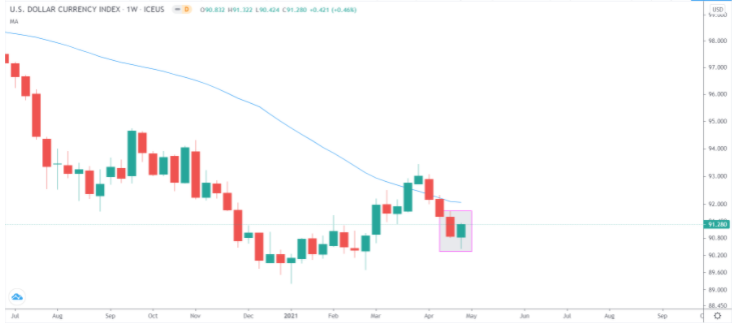
★
Summary
★
The U.S. Dollar strengthened across the board in the last trading day of April, recording its biggest one-day gain in April, with monthly, weekly and daily charts closing at high levels, which was very favorable for the short-and medium-term trend of the dollar in May. Combined with US fundamentals, the expectation of economic recovery is still the potential driving force for the dollar to return to rising.

The Economic Data are Beautiful
1. US gross domestic product (GDP) grew by 6.4% in the first quarter, much higher than 4.3% in the previous quarter, indicating the acceleration of US economic growth. Under the premise of accelerated vaccination and relaxation of epidemic restrictions, the $1.9 trillion aid and $2.3 trillion infrastructure plan approved by the Biden government in March are expected to push the US second-quarter GDP data to the next level.
2. The US Markit manufacturing, service and comprehensive PMI all set a record high in April. The Chicago Purchasing managers Index released yesterday recorded 72.1, exceeding expectations of 63, the highest level since January 1984. The PMI index usually takes 50 as the rise and fall line, and more than 50 indicates that the economy is expanding. The final consumer confidence index of the University of Michigan in April, 88.3, was also better than the expected 87.4.
3. Inflation in the United States is growing rapidly. Us inflation data rose significantly along with massive stimulus and unlimited quantitative easing, with US CPI rising 2.6 per cent in March from a year earlier, the highest since August 2018, and 0.6 per cent month-on-month, the highest since July 2020. Us retail sales rose 9.8 per cent in March from a month earlier, well ahead of expectations of 5.8 per cent and the biggest increase since May 2020, while core retail sales rose 8.4 per cent from a month-on-month decline of 2.7 per cent. The annualized rate of core PCE in the first quarter of last year was the highest since the first quarter of last year, and the annual rate of consumer spending was the highest since the third quarter of last year. Us PPI data rose 1 per cent in March from a month earlier, 0.5 per cent in February, and core PPI, which excludes food and energy, rose 0.7 per cent from a month earlier. On a year-on-year basis, overall PPI rose 4.2 per cent in March from a year earlier, the biggest year-on-year increase since 2011. In response to the strong inflation data, Federal Reserve Chairman Powell believes that this is temporary and that the uncertainty brought about by the COVID-19 epidemic will not change the current situation that the US economy still needs to inject more loose money supply to help.
4. Employment data. Statistics show that nearly 30 per cent of Americans have been fully vaccinated against COVID-19, more and more companies have reopened, air travel activities are gradually resuming, and retail store traffic is on an upward trajectory. The number of new jobs in March was as high as 916000, and both economists and Wall Street are optimistic that the number of new jobs in April exceeded 1 million. If the number of new non-farm payrolls in April does exceed 1 million, it will be the first time that it has reached such a high level since August last year. Federal Reserve Chairman Colin Powell said in the April interest rate resolution that "the unemployment rate is still high, and the March employment report is gratifying but far from enough." May's non-farm payrolls report will be released on May 7, which is definitely an important moment.
This Week's American Economic Calendar is Full of Risks
The first week of May can be said to be a bumper harvest for the US dollar. After a persistently negative April, the economic calendar is rife with event risk, which is likely to provide traders with plenty of opportunities to take advantage of fluctuations in dollar currency pairs in the coming days.
On Monday, May 3, the US Markit Manufacturing PMI and US ISM Manufacturing PMI reports will be released after the opening of the New York stock market. Also on Monday, Federal Reserve Chairman Colin Powell will make a speech. The Atlanta Fed's GDPNow growth tracking data for the second quarter of 21 will be updated three times this week.
On Tuesday, May 4, the March factory order report in the United States will be released. The Atlanta Fed's GDPNow growth tracking data for the second quarter of 21 will be updated for the second time.
On Wednesday, May 5, the US April ADP employment change report, as well as April ISM non-manufacturing PMI and EIA energy inventory data for the week ended April 30 will be released.
On Thursday, May 6, data on initial jobless claims in the United States for the week ended May 1 and data on renewed jobless benefits in the United States for the week ended April 24 will be released.
On Friday, May 7, U.S. non-farm payrolls data and April unemployment data as well as April wage growth data will be released. The Atlanta Fed's GDPNow growth tracking data for the second quarter of 21 will be updated for the third and final time this week.
Risk Warning: The above content is for reference only, and does not represent JRFX’s position. JRFX does not assume any form of loss caused by any trading carried out in accordance with this article. Please consult your financial planner for your investment portfolios and manage your own risk.
JRFX is an online CFD broker providing more than 50 products for Forex, metals and commodities. Open a trading account within a minute. Deposit 100USD and download our MT4 trading platform now!

|

|

|

|

Views: 117396

Likes: 0